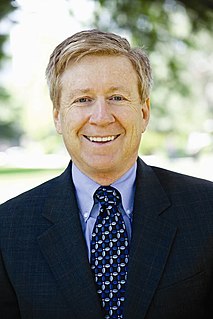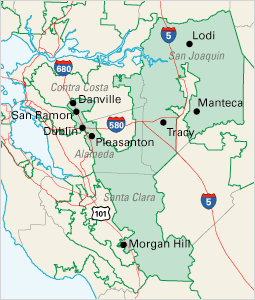Related Research Articles

The government of California is the governmental structure of the U.S. state of California as established by the California Constitution. California uses the separation of powers system to structure its government. It is composed of three branches: the executive, consisting of the Governor of California and the other constitutionally elected and appointed officers and offices; the legislative, consisting of the California State Legislature, which includes the Assembly and the Senate; and the judicial, consisting of the Supreme Court of California and lower courts. There is also local government, consisting of counties, cities, special districts, and school districts, as well as government entities and offices that operate independently on a constitutional, statutory, or common law basis. The state also allows direct participation of the electorate by initiative, referendum, recall and ratification.

Los Angeles County, officially the County of Los Angeles, and sometimes abbreviated as L.A. County, is the most populous county in the United States and in the U.S. state of California, with more than ten million inhabitants as of the 2020 census. It is the most populous non–state-level government entity in the United States. Its population is greater than that of 40 individual U.S. states. Los Angeles County has the 3rd largest metropolitan area economy in the world, with a nominal GDP of more than $1.0 trillion. At 4,083 square miles (10,570 km2) and with 88 incorporated cities and many unincorporated areas, it is larger than the combined areas of Delaware and Rhode Island. The county is home to more than one-quarter of California residents and is one of the most ethnically diverse counties in the United States. Its county seat, Los Angeles, is also California's most populous city and the second most populous city in the United States, with about four million residents.

The United States District Court for the Central District of California is a Federal trial court that serves over 19 million people in Southern and Central California, making it the most populous federal judicial district. The district was created on September 18, 1966. Cases from the Central District are appealed to the United States Court of Appeals for the Ninth Circuit. Along with the Central District of Illinois, the court is the only district court referred to by the name "Central" – all other courts with similar geographical names instead use the term "Middle."
Same-sex marriage is legal in the U.S. state of California. The state first issued marriage licenses to same-sex couples June 16, 2008 as a result of the Supreme Court of California finding in In re Marriage Cases that barring same-sex couples from marriage violated the state's Constitution. The issuance of such licenses was halted from November 5, 2008 through June 27, 2013 due to the passage of Proposition 8—a state constitutional amendment barring same-sex marriages. The granting of same-sex marriages recommenced following the United States Supreme Court decision in Hollingsworth v. Perry, which restored the effect of a federal district court ruling that overturned Proposition 8 as unconstitutional.

The California Courts of Appeal are the state intermediate appellate courts in the U.S. state of California. The state is geographically divided along county lines into six appellate districts. The Courts of Appeal form the largest state-level intermediate appellate court system in the United States, with 106 justices.

The California State Board of Equalization (BOE) is a public agency charged with tax administration and fee collection in the state of California in the United States. The authorities of the Board fall into four broad areas: sales and use taxes, property taxes, special taxes, and acting as an appellate body for franchise and income tax appeals. The BOE is the only publicly elected tax commission in the United States. It is made up of four directly elected members, each representing a district for four-year terms, along with the State Controller, who is elected on a statewide basis, serving as the fifth member. In June 2017, Governor Jerry Brown signed legislation stripping the Board of many of its powers, returning the agency to its original core responsibilities.

California's 47th congressional district is a congressional district in the U.S. state of California. The district is centered in Long Beach, extends into the western Orange County cities of Garden Grove, Westminster, Stanton, Buena Park, Los Alamitos, and Cypress, the unincorporated community of Rossmoor, and includes Catalina Island. The district is represented by Democrat Alan Lowenthal, who is planning to retire in 2022.

California's State Assembly districts are numbered 1st through 80th, generally in north-to-south order.

Superior courts in California are the state trial courts with general jurisdiction to hear and decide any civil or criminal action which is not specially designated to be heard in some other court or before a governmental agency. As mandated by the California Constitution, there is a superior court in each of the 58 counties in California. The superior courts also have appellate divisions which hear appeals from decisions in cases previously heard by inferior courts.

George C. Runner, Jr. is an American politician from California who served on the California State Board of Equalization, the only publicly elected tax commission in the United States. A Republican, he represented the Board's 2nd District from 2011 to 2015 and the renumbered 1st District from 2015 to 2019.

Electoral reform in California refers to efforts to change election and voting laws in the U.S. state of California.

California's state elections were held November 8, 1994. Necessary primary elections were held on June 7. Up for election were all the seats of the California State Assembly, 20 seats of the California Senate, seven constitutional officers, all the seats of the California Board of Equalization, as well as votes on retention of two Supreme Court justices and various appeals court judges. Ten ballot measures were also up for approval. Municipal offices were also included in the election.

Proposition 11 of 2008 was a law enacted by California voters that placed the power to draw electoral boundaries for State Assembly and State Senate districts in a Citizens Redistricting Commission, as opposed to the State Legislature. To do this the Act amended both the Constitution of California and the Government Code. The law was proposed by means of the initiative process and was put to voters as part of the November 4, 2008 state elections. In 2010, voters passed Proposition 20 which extended the Citizen Redistricting Commission's power to draw electoral boundaries to include U.S. House seats as well.

The Superior Court of California, County of Los Angeles, is the California superior court with jurisdiction over Los Angeles County, which includes the city of Los Angeles. It is the largest single unified trial court in the United States.

The California Citizens Redistricting Commission is the redistricting commission for the State of California responsible for determining the boundaries of districts for the State Senate, State Assembly, and Board of Equalization. The commission was created in 2010 and consists of 14 members: five Democrats, five Republicans, and four from neither major party. The commission was created following the passage in November 2008 of California Proposition 11, the Voters First Act. The commissioners were selected in November and December 2010 and were required to complete the new maps by August 15, 2011.

Riverside County is a county located in the southern portion of the U.S. state of California. As of the 2020 census, the population was 2,418,185, making it the fourth-most populous county in California and the 10th-most populous in the United States. The name was derived from the city of Riverside, which is the county seat.

A California Congressional Redistricting Initiative, Proposition 20 was on the November 2, 2010 ballot in California. It was approved by 61.2% of voters. Election officials announced on May 5 that the proposition had collected sufficient signatures to qualify for the ballot. The measure is known by its supporters as the VOTERS FIRST Act for Congress.

Redistricting in California has historically been highly controversial. Critics have accused legislators of attempting to protect themselves from competition by gerrymandering districts. Conflicts between the governor and the legislature during redistricting often have only been resolved by the courts.

California state elections in 2018 were held on Tuesday, November 6, 2018, with the primary elections being held on June 5, 2018. Voters elected one member to the United States Senate, 53 members to the United States House of Representatives, all eight state constitutional offices, all four members to the Board of Equalization, 20 members to the California State Senate, and all 80 members to the California State Assembly, among other elected offices.
Rider v. County of San Diego, 820 P.2d 1000 was a California Supreme Court case where the court ruled that a sales tax in San Diego County, California to fund courthouses and jails was invalid, because it failed to reach a two-thirds voter approval as required by Proposition 13.
References
- ↑ "Final Report on 2011 Redistricting" (PDF). State of California. 2011. Archived from the original (PDF) on May 23, 2013. Retrieved February 27, 2013.
- ↑ State Board of Equalization, 2018-19 Annual Report, Profile, "Governance" p. 8.
- ↑ State Board of Equalization, Board Members
